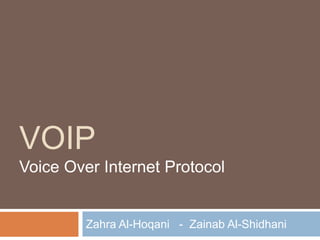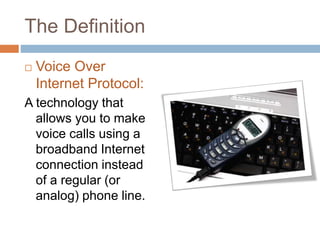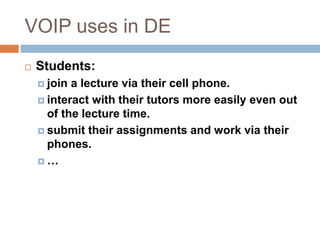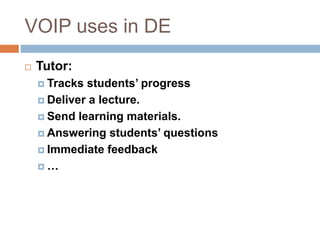VOIP(Voice Over Internet Protocol)
- 1. VOIP Voice Over Internet Protocol Zahra Al-Hoqani - Zainab Al-Shidhani
- 2. The Definition ’é© Voice Over Internet Protocol: A technology that allows you to make voice calls using a broadband Internet connection instead of a regular (or analog) phone line.
- 3. Advantages (features) ’é© Low cost ’éż Pc to Pc ’éż Pc to phone ’éż Monthly fee ’é© Portability ’é© Advanced communication features: ’éż Call waiting, ’éż Voicemail
- 4. Disadvantages ’é© No service during a power outage. ’é© Emergency 911 calls. ’é© Reliability
- 5. VOIP uses in DE ’é© Students: ’éż join a lecture via their cell phone. ’éż interact with their tutors more easily even out of the lecture time. ’éż submit their assignments and work via their phones. ’éż ŌĆ”
- 6. VOIP uses in DE ’é© Tutor: ’éż Tracks studentsŌĆÖ progress ’éż Deliver a lecture. ’éż Send learning materials. ’éż Answering studentsŌĆÖ questions ’éż Immediate feedback ’éż ŌĆ”
- 7. VOIP uses in DE ’é© Audio-conferencing ’é© Inviting an expert ’é© Orientation
- 9. Connectivity ’é© VOIP service (computer/VOIP telephone/ phone + adapter) to: ’éż Any one has telephone number (locally, long distance, internationally) ’ü« Mobile. ’ü« Traditional phone. ’éż Computer: ’ü« Uses the same service.
- 10. How VoIP Works?
- 11. Software .. ’é© Skype ’é© Vonage ’é© Nice Call Back ’é© intervoip
- 12. Real VOIP call... LetŌĆÖs try itŌĆ”
- 13. Features analysis Synchronous Time of interaction Asynchronous Student-student Type of interaction Student-teacher Student-content Student-machine Group-based Learning style Self-based learning Anytime Flexibility Anyplace Ease of access/use Development Speed Feedback Delivery Stand-alone medium Instruction Multimedia support Cost
- 14. 1 Synchronous Time of interaction 1 Asynchronous 1 Student-student Type of interaction 1 Student-teacher 0 Student-content 0 Student-machine 1 Group-based Learning style 1 Self-based learning 1 Anytime Flexibility 1 Anyplace 1 Ease of access/use 1 Development Speed 1 Feedback 1 Delivery 0 Stand-alone medium Instruction 0 Multimedia support 1 Cost 13/ 17 Features analysis













